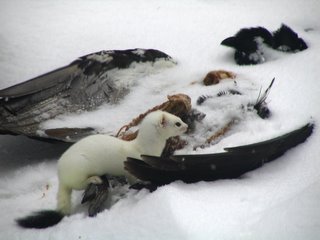Friday, November 11, 2005
Metson 12 matkan pää - End of track, Capercaillie 12
 Vuodesta 1998 Värrön tutkimusasemalla on asennettu radiolähetin (panta) yhteensä 85 maastosta häkkiloukulla pyydetylle metsolle. Samalla metsot on rengastettu. Metso 12 tuli tiensä päähän 11.1.2005. Se löytyi kuolleena Kuntasjoen länsipuolelta. Kettu oli ilmeisesti onnistunut yllättämään vanhan urosmetson 4-5 päivää aikaisemmin, tai metso oli kuollut vanhuuttaan, ja kettu oli sen heti löytänyt. Se oli käynyt syömässä metsoa useita kertoja ennenkuin tutkimusavustaja Sampo Ollila löysi raadon vielä toimivan radiolähettimen signaalin avulla. Hän toi metson tutkimusasemalle, jossa se tutkittiin läpikotaisin, nilkkarengas poistettiin, ja radiolähetin irroitettiin odottamaan tulevia uusia pyyntejä. Metson raato vietiin sen jälkeen tarkkailuhaaskaksi hangelle tutkimusaseman takapihalle. Sieltä metson löysi ruoakseen kärppä (kuvassa). Metso 12 palautui näin Värriön luonnonpuiston kiertoon.
Vuodesta 1998 Värrön tutkimusasemalla on asennettu radiolähetin (panta) yhteensä 85 maastosta häkkiloukulla pyydetylle metsolle. Samalla metsot on rengastettu. Metso 12 tuli tiensä päähän 11.1.2005. Se löytyi kuolleena Kuntasjoen länsipuolelta. Kettu oli ilmeisesti onnistunut yllättämään vanhan urosmetson 4-5 päivää aikaisemmin, tai metso oli kuollut vanhuuttaan, ja kettu oli sen heti löytänyt. Se oli käynyt syömässä metsoa useita kertoja ennenkuin tutkimusavustaja Sampo Ollila löysi raadon vielä toimivan radiolähettimen signaalin avulla. Hän toi metson tutkimusasemalle, jossa se tutkittiin läpikotaisin, nilkkarengas poistettiin, ja radiolähetin irroitettiin odottamaan tulevia uusia pyyntejä. Metson raato vietiin sen jälkeen tarkkailuhaaskaksi hangelle tutkimusaseman takapihalle. Sieltä metson löysi ruoakseen kärppä (kuvassa). Metso 12 palautui näin Värriön luonnonpuiston kiertoon.Metso 12 pyydettiin ensimmäisen kerran 6.5.1998 Hirvasjoen itäpuolella rajavyöhykkeellä sijaitsevalla soidinsuolla. Kenttämestari Kaarlo Koskinen asensi sille radiopannan (lähettimen) kaulaan ja numeroidun alumiinirenkaan nilkkaan. Tulevina vuosina metso 12:stä tehtiin paljon havaintoja. Kotimaisemastaan, Hirvasjoen laaksosta se ei radiopeilausten mukaan poistunut koskaan. Sille vaihdettiin uusi radiolähetin keväällä 2000. Viimeisen kerran metso 12 pyydystettiin keväällä 2004, se sai uuden radiolähettimen ja samalla se punnittiin. Vanhalla ukolla oli painoa 3777 grammaa. Ikääntyminen oli alkanut jo pudottaa sen painoa. Erkki Pulliainen totesi, että "Värriön alueella raavas metso painaa tyypillisesti vähän yli neljä kiloa, mutta vanhetessaan lintu alkaa pienetä. Esimerkiksi tutkimusmetso numero 12 näyttäisi painon perusteella oleen kuollessaan 10-15 -vuotias. Sen elimistö oli alkanut rappeutua ja elämä käydä raskaaksi."
Loppuvuonna 2005 metso 12 sai lisäarvoa. Sen rengastusikä ensimmäisestä loukkupyynnistä viimeiseen löytymiseen oli 6 vuotta 8 kuukautta 5 päivää. Juuri ilmestynyt Rengastajan vuosikirja 2005 kertoo, että rengastusiältään Suomen vanhin metso oli tähän asti 6 v 2kk 24 p, eli Värriön metsovanhus ottaa Suomen ennätyksen haltuunsa.
Aiheesta myös: Sipola, T. Värriön aineisto on ainutlaatuista. Ympäristö 7/2005:29-31, ja Rengastajan vuosikirja 2005, s. 50.
Since 1998 altogether 85 Caperciallies (Tetrao urogallus) in the surroundings of Varrio research station have been equipped with radio transmitters. The birds had been captured in wintertime with a trap that has been developed in the station. During the capture the birds also got an ordinary numbered aluminium ring, used in in bird ringing.
Capercaillie number 12, an old male, was found dead on 11 January 2005 on the western bank of Kuntas river. Based on the traces on the snowy ground it seemed that a fox had managed to attack the capercaillie and kill it 4-5 days earlier. Or it may have happened that the old bird had just died and the fox had immeidately found the carcass.
The fox had eaten the carcass several timed before the research assistant of the station, Mr. Sampo Ollila traced the dead bird as the radio transmitter kept sending the signal. He brought the Capercaillie to the station. The bird was examined, the radio transmitter was removed and the numbered ring was released. Afterwards the carcass of the Capercaillie was placed outside in the snow in the backyard of the station, for carcass monitoring. It was soon found by hermelin (in the photo) that started to eat the carcass. Thus Capercaillie 12 slowly returned to the eternal cycle of matter in the Varrio nature reserve.
Capercaillie 12 was captured for the first time on 6 May 1998 east of Hirvas river. The research technician, Mr. Kaarlo Koskinen installed the first radio transmitter and ringed the bird. In the coming years great many observations were done on the movements of the bird. It was remarkable that the bird was very faithful to its home area; it never moved away from Hirvas river creek and the nearby forests. Anew transmitter was installed in spring 2000 and the last one in spring 2004.
During the last capture the weight of the old male bird was 3777 grams. It had passed the top weight. Professor Erkki Pulliainen has noted that full-grown male caopercaillies in Varrio weigh typically a little over four kilograms. The Capercaillie No 12 had started to loose its weight, and based on this its age is 10-15 years. It is high age for capercaillie, and it is no wonder if it had just died because of its age, or if it had weakened so that that the fox managed to capture it.
In late 2005 the capercaillie 12 got another merit. The recent annual report of Finnish bird ringing noted that so far the longest ringing period for a ringed capercaillie has been 6 years 2 months and 24 days. The oldie of Varrio hit the record. The period between the original ringing and the final release of the ring was 6 years 8 months and 5 days. The Capercaillie 12 is thus the Finnish champion in its field.
Two interesting (Finnish) references tell more about the topics: 1) Sipola, T. Värriön aineisto on ainutlaatuista. Ympäristö 7/2005:29-31, and 2) Rengastajan vuosikirja 2005, p. 50.